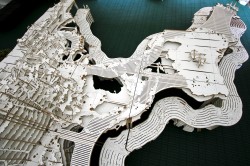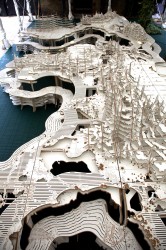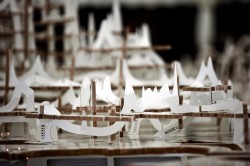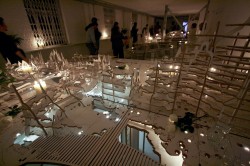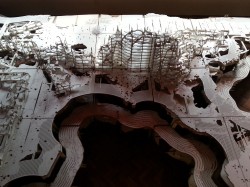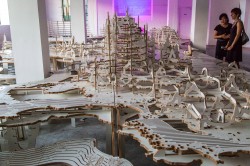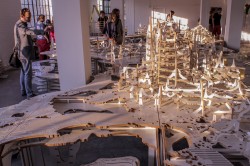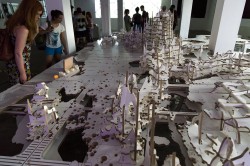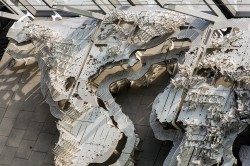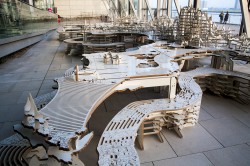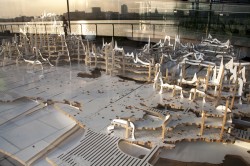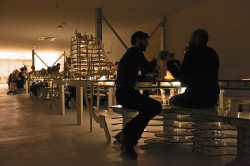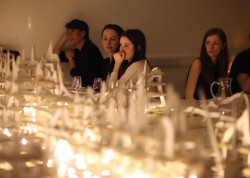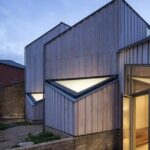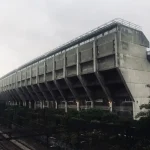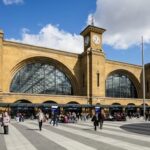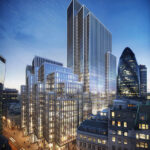Worldscape, Dining Landscape, Global Feast, Culinary Exploration London Olympics 2012
Worldscape – Dining Landscape
Global Feast Event: Contemporary Interior in London, UK – design by atmos architects
26 Dec 2014
Worldscape Global Feast Event
Location: London, England, UK
Design: atmos
Worldscape London
Dining Landscape at London Olympics 2012
Worldscape is a vast dining landscape seating 80 people around the geometry of our planet, and first conceived and executed for Global Feast – 20 sequential evenings of world culinary exploration over the course of the London Olympics 2012.
Combining table and bench, its deeply sculptural landscape uses all the world’s contours to create a smorgasbord of unique inhabitable spaces – faithful to world geographic geometry, yet deeply unfamiliar as furniture. As a social instrument, it frames and prompts new and unprecedented dining relationships, encouraging intimacy and interaction between its occupants.
Worldscape continues atmos’s fascination with conjuring space from data, and creating immersive ergonomic environments. It uses the Equidistant Cylindrical map of the world, where all degrees are equal lengths in both directions, to create an inhabitable dining environment. Though it dates back to 100AD, it is NASA’s digital map of choice because it clearly maps the world onto square pixels. Appropriately enough for a dining experience, this map type is also called Plate Carrée.
The table maps world contours onto the readily-available shapes of industrial materials. The 360-degree length of the map is divided into 12, each strip measuring 30 terrestrial degrees in width, mapping perfectly onto 4-foot-wide sheets of melamine-faced plywood. These sheets are carved with contours – outlines of the world’s geography cut at 500-metre intervals – using digital fabrication to cut straight from the computer with ultimate speed and exactitude. The table is thus divided into a grid of 35 generally-square modules of irregularly-shaped landmasses, each deeply individual yet linking together to form a collective occupiable landscape.
The table uses all the world contours, from both above and below sea level, stretching their vertical relationship – like an engineer’s section of a bridge – to best fit the body. Diners sit inside the sea – astride a collective semi-transparent bench running the length of the ocean trench, 2 kilometres beneath the ocean surface – and eat off the sea-level coastline – the image we all recognise as a world map. Table and bench interlock together, their structural front edges describing a local sectional cut through the world.
Ocean contours cascade away beneath the seats, terminating at 5 kilometres below sea level as they hit the venue floor – while the mountains rise up above the table to peak at the Himalayas – 2.1 metres tall – making Worldscape the tallest table in (and of) the world. The main surfaces at sea level are striated by the longitudinal lines that compartmentalise our event calendar, and perforated with the patterns of global cities. Each table cradles multiple light sources which illuminates these urban constellations; the view from above thus replicates the satellite view of the Earth at Night, diners illuminated by our collective inhabitation of the Earth.
The carved modules can interlink or detach, unfolding and unscrewing to pack flat as carry-away demountables. Their complex geometries all conform to the terrestrial grid, meaning longitudinal slices can be swapped out and recombined to create new map forms; indeed any grid square could connect to any other, creating entirely new world organisations and creative cartographic mashups. The tables can be pulled apart to create café-style seating, and each packs away into a slim stack of easy-assemble components – both a unique designer object, and a portable slice of the world.
History
Worldscape was first constructed for the London Olympics 2012 at Stratford Old Town Hall. It has since been exhibited at the Building Centre (Store Street WC1), Newham Dockside, and the LimeWharf Gallery (Vyner Street E14).
Material
Worldscape is an indicative 3d-jigsaw of components digitally cut from 8×4’ sheets of 18mm melamine-faced birch plywood.
Compositon
The 36-module table and benches all form interlinking flatpack elements that can be attached to form a 12-module-long whole, or detached to sit independently. Once interlocked, the modules are strong enough to support the weight of people standing on it – and were the platform for various performances during London 2012. Each module has varying degrees of mountain landscape (some have none, while the highest Himalayan peak stretches to 2m above ground level); each coastal element has its own interlocking bench (45cm high). The modules are linked together by 2 sets of simple bolted connections along their legs, which can also be unscrewed so that the tables pull apart to create separate café-style seating of these unique designer objects.
Transport
The quickest and most efficient way to transport Worldscape is to keep the individual modules built, but to detach and stack them, and the clusters of mountains and benches, separately. Over the course of an extended day, 2-3 people can demount, pack, move and rebuild the entire installation between relatively close destinations using 3 full loads of a typical Luton Van.
The individual modules themselves can be unscrewed and folded down to pack flat as carry-away units – a technique that requires extensive packaging, and entails much more time.
Worldscape Global Feast London – Building Information
Project Team
Concept & Design: atmos (Alex Haw, Pablo Milara, Friedrich Vitzthum)
Development: Alex Haw, Pablo Milara, Friedrich Vitzthum, Dom Rago-Verdi, XiaoLin Gu, Melissa Reynaud, Ana Maria Diaz, Ana Sidorova, Nick O’Neill, Dan Mahoney, Chris Green, Jeg Dudley, Rowan Taylor
Construction: above + Anibal Puron, Martin, Sinead Mac Manus, Stefan Simanowitz, Marcus Keohane, Jonathan Taylor, Leo, William Hardie, Andrew Atkins, Anke Weber
Fabrication: kindly sponsored by The Cutting Room (very special thanks to Mark Durey)
Plywood: kindly sponsored by DHH Timber
With very special thanks to Thomas Ugo Ermacora (Lime Wharf), Alison Davenport (Stratford Old Town Hall), and Sinead Mac Manus – the very centre of this world.
Resources
Project Website: http://globalfeast2012.com/
Facebook Page: http://www.facebook.com/atmosworldscape
Atmos project webpage: http://www.atmosstudio.com/worldscape
http://www.atmosstudio.com/worldscape2
Pictures:
http://www.mediafire.com/folder/37x59g76qhpll/03-TABLE-NO-PEOPLE-
http://www.mediafire.com/folder/5xgfvapb2q9b4/05-AlexHaw-StratfordOldTownHall-good-
http://www.mediafire.com/folder/fvukk2duz3ry9/08-AlexHaw-NewhamDockside-good-
http://www.mediafire.com/folder/83pw2wwpslmv3/04-BEST-of-the-best-EVENINGS-by-all
FinalDrawings: http://www.mediafire.com/folder/2fio7lr6zilc3/-FINAL_DRAWINGS-
Online Brochures:
http://www.files.atmosstudio.com/public/150-Worldscape-A4Brochure-18p–atmos-HI.pdf
http://www.files.atmosstudio.com/public/150-Worldscape-A4Brochure-18p–atmos-med.pdf
http://www.files.atmosstudio.com/public/150-Worldscape-A4Brochure-3p–atmos-HI.pdf
http://www.files.atmosstudio.com/public/150-Worldscape-A4Brochure-3p–atmos-med.pdf
Video:
https://www.youtube.com/watch?v=gSsYptEpMTc&feature=share&list=PLz6LhwhDR5pEzgdoFH4aE7zb6WUla1HTx
https://www.youtube.com/watch?v=gimO33m24ZI&feature=share&list=PLz6LhwhDR5pEzgdoFH4aE7zb6WUla1HTx
Worldscape images / information from atmos
Address: The Old Town Hall, 29 Broadway, Stratford, London E15 4BQ
Phone: 020 3373 7033
Location: The Old Town Hall, 29 Broadway, Stratford, London E15 4BQ, England, UK
Architecture in London
Contemporary Architecture in London
London Architecture Links – chronological list
London Architecture Walking Tours
Designs by atmos on e-architect:
Roominaroom in London – Limehouse apartment
The Bougheries Structure, New York City, USA
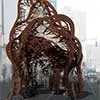
image from architect
The Bougheries Structure
Comments / photos for the Worldscape – Stratford Old Town Hall Event page welcome

